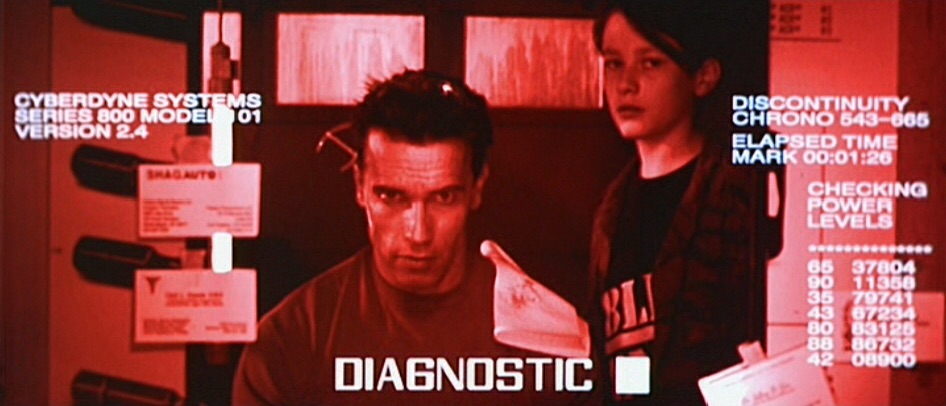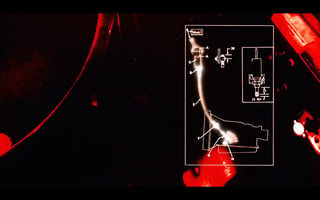I was actually putting together my own question about this exact subject when I found this question.
From what I have gathered, there seem to be a couple of possibilities, which are probably both accurate to different degrees.
Out-of-Universe:
The HUD is a narrative device, intended to let the audience in on the Terminators' thought processes. Let's take a look at a screenshot of one example of the HUD:

By showing us this image, the director can convey information about how the Terminator is assessing its surroundings and making decisions. The only other way this could be achieved is to have the Terminator actually talk to itself, or act as a narrator, and explain what it is seeing, thinking, and how it is making its decisions; to have the Terminator do this would make no sense, and would pull the audience out of the moment, breaking the willful suspension of disbelief, and destroying the illusion of being present in the situation.
Another example (with some NSFW text):

This is from a scene in the first Terminator movie, in which the Terminator is in his flophouse apartment repairing some damage to his face. The landlord comes to the door, having smelled the rotting flesh of the Terminator, and asks if there is a dead cat in the room. The Terminator's HUD displays a list of possible responses to the landlord's question, and (hilariously), the Terminator chooses the most offensive option.
In this case, the narrative device of the HUD is even more useful than it is in the second movie, because the first Terminator is an enigma to us as the audience. We get very little insight into the "mind" of the character, and we never know what he is thinking. He is entirely remote, alien, and emotionless, and there is no way to relate to him. He is a completely unsympathetic character. By giving us a glimpse of his mindset and thought process, we get a better feel for the character. It is a brilliant device, because it simultaneously allows us to see the world through the Terminator's eyes, and spy in its inner thoughts, but it also reinforces the idea that this thing is cold, calculating, and completely devoid of any human feelings.
In-Universe:
The HUD doesn't make sense if you assume that Terminators were never anything more than the tools Skynet uses to destroy humanity. If the Terminators were designed and built by Skynet without any input from humans, an HUD would be totally unnecessary, and in fact, actively detrimental to the Terminators' mission. By using a visual, graphic display system, the Terminator is wasting CPU space and slowing down its decision making process.
But the first Terminators were originally designed by humans, and these humans didn't expect that their creations would eventually turn against them. The designers and programmers expected to control the Terminators in much the same way people control military drones. Once the Terminators were operational, they would be operated by humans, and these humans would need to see a visual, graphic display. This display would have to be easy to understand, and it would have to provide information about the status of the Terminator's systems, as well as a video feed of what the Terminator was seeing. The operators would also need to see a display of options to choose from, related to what instructions the Terminator would be given, how it should react to its situation, targeting priorities, mission parameters, and so on.
Therefore, at the time the Terminators were being designed and assembled, the HUD was absolutely vital to their operation. This changed, however, when Skynet took over and set the Terminators to its own purposes. From that point on, we might argue that the HUD was no longer necessary, and was actively detrimental to the Terminators' operations. Again, it wastes memory, consumes an inordinate amount of processing speed and CPU functionality, and slows down the decision making process.
At this point, we might say that the HUD had become a spandrel: something that is still used and replicated in successive generations of Terminators, but which serves no purpose whatsoever. Since humans aren't controlling the Terminators anymore, a user friendly interface is worse than useless. Even the language of the HUD - a mix of English and processing languages - makes no sense.
Summary:
So, in short, the HUD was a logical feature for as long as humans were in charge of the design process, but once Skynet took over, it became unnecessary. Skynet may have continued to use the HUD for reasons which are unclear to us, but the most practical reason for its use in the movies is the opportunity it provides the audience to see the world through the eyes of the Terminators, and to convey information that would otherwise have to be spoken aloud by the Terminators, which would not make sense.
Think of the scene in which the Terminator scans the big biker dude to see if his clothes are the right size. Now imagine what the scene would be like if the Terminator was saying the things that appear in the HUD the whole time:
"Your inseam is the correct size. Your waist is the correct size. Your chest is the correct size. Your sleeves are the correct size. Your shoes are the correct size. Your shoulders are the correct size. Your neckline is the correct size. Your clothes are the correct size. I need your clothes, your boots,and your motorcycle. Give them to me. Now."
See why that wouldn't work?
The point is this: In-universe, during the initial stages of development, it made sense to use an HUD. Out-of-universe, it always made sense to use an HUD. You can attribute however much significance to each of these factors as you like.
I think the best way to interpret the HUD is on a case by case basis. For example, this screenshot of an HUD display from Terminator 2: Judgement Day only makes sense for out-of-universe reasons:

Whereas this image, from a deleted scene from the same movie, in which the Terminator is rebooting after having been shut down temporarily so John and Sarah could switch its CPU from a "read only" setting to a sort of "learning mode" setting, makes sense in both the out-of-universe and the in-universe contexts:
 Note: If you are wondering why the Terminator sees himself in this picture, it's because he is looking into a mirror.
Note: If you are wondering why the Terminator sees himself in this picture, it's because he is looking into a mirror.




 Note: If you are wondering why the Terminator sees himself in this picture, it's because he is looking into a mirror.
Note: If you are wondering why the Terminator sees himself in this picture, it's because he is looking into a mirror.


